6.9.1 Genera概述
6.9.1.1 The topics of critical speed and lateral analysis are covered under each specific pump type in Section 9.
临界转速和横向分析的主题将在第 9 节中的每种特定泵类型下进行阐述。
::: tip
解释:横向分析在转子动力学中,主要用于研究转子的横向振动特性,包括固有频率、临界转速、不平衡响应、稳定性等。横向分析的步骤包括建立转子-轴承系统的力学模型,采用有限元法或传递矩阵法求解转子的运动方程,绘制坎贝尔图和响应曲线,分析转子的振动形态和失衡方式,确定平衡方法和平衡工艺等。横向分析可以帮助设计和优化转子系统,提高转子的效率和可靠性,减小转子的振动和噪声。
:::
6.9.1.2 The rotor of one- and two-stage pumps shall be designed so its first dry-bending critical speed is at least 20 % above the pump s maximum continuous operating speed.
单级和两级泵的转子在设计上应使其第一干弯曲临界转速至少比泵的最大连续运行转速高 20%。
6.9.1.3 To obtain satisfactory seal performance, the shaft stiffness shall limit the total deflection, under the most severe dynamic conditions over the allowable operating range of the pump with maximum diameter impeller(s) and the specified speed and liquid, to 0.002 in. (50 μm) at the primary seal faces. This shaft-deflection limit may be achieved by a combination of shaft diameter, shaft span or overhang, and casing design (including the use of dual volutes or diffusers). For one- and two-stage pumps, no credit shall be taken for the liquid stiffening effects of impeller wear rings. For multistage pumps, the liquid stiffness of wear rings, product-lubricated bearings, and bearing bushings shall be calculated at both one and two times the nominal design clearances.
为了获得令人满意的密封性能,轴的刚度应限制主密封面的总变形量,即在最大直径叶轮和规定速度及液体的泵允许工作范围内,在最恶劣的动态条件下,总变形量不超过 0.002 英寸 (50 μm)。为了限制轴挠度,可通过轴直径、轴跨度或悬伸以及外壳设计(包括使用双蜗壳或导流壳)的组合来实现。对于单级和双级泵,不应计入叶轮耐磨环的液体加固效应。对于多级泵,耐磨环、产品润滑轴承和轴承衬套的液体刚度应按一倍和两倍的额定设计间隙计算。
::: tip
解释:本条对轴的变形要求很严格,无论多恶劣情况,轴的变形总量不能超过50微米。双蜗壳泵(如下图)相对于单蜗壳可以比较好的限制轴变形。但是最好限制轴变形的手段还是增大轴的直径和减小轴的跨度。对于多极泵体液体的刚度,应该至少考虑一倍和两倍的额定间隙。
 :::
:::
6.9.2 Torsional Analysis扭转分析
6.9.2.1 The flow chart in Figure 29 shall be utilized to determine the torsional analysis performed. The analysis shall be for the train as a whole unless the train includes a fluid coupling. In all cases, the vendor having unit responsibility shall be responsible for directing any modifications necessary to meet the requirements of 6.9.2.3 through 6.9.2.9.
必须使用图 29 中的流程图来确定所进行的扭转分析。除非整个系列包括液力偶合器,否则必须对整个系列进行分析。在所有情况下,负有单位责任的供应商应负责指导任何必要的修改,以满足 6.9.2.3 至 6.9.2.9 的要求。
::: tip
解释:和横向分析不同的是扭转分析是基于扭转力的。而且扭转分析必须对整个系统做分析。比如说一台电机带着一台齿轮箱带着一台泵,那么我做扭转分析的时候,必须将齿轮箱建模,将电机建模,将泵建模作为一个系统来分析。但是横向分析可以按照泵分析,按照电机分析,按照尺寸分析,可以单个进行分析。横向分析得出的结果是横向临界转速,而扭转分析得出的结果是扭转临界转速。
:::
NOTE There are three general types of torsional analyses normally performed on pumps:
注:通常对泵进行三种类型的扭转分析:
::: tip
解释:以下三种类型的扭转分析,严格程度依次提高。先做无阻尼,再做稳态强迫,再做瞬态强迫。
:::
a) undamped natural frequency analysis that determines modes of the rotor's torsional natural frequencies and generates a Campbell diagram to determine potential resonance points;
无阻尼固有频率分析,可生成坎贝尔图,以确定潜在的共振点;
b) steady-state forced response analysis that determines the rotor's harmonic response to applicable steady-state excitation sources (e.g. dynamic torque functions) and generates dynamic torsional torques and stresses to evaluate mechanical integrity;
稳态强迫响应分析,适用于稳态激励源(如动态扭矩函数),并产生动态扭转扭矩和应力,以评估机械完整性;
c) transient forced response analysis that determines the rotor's forced response to applicable transient excitation sources (e.g. motor starting and short-circuit events) and generates dynamic torsional torques and stresses to evaluate mechanical integrity.
瞬态强迫响应分析,适用于瞬态激烈源(如电机启动和短路事件)并产生动态扭转扭矩和应力,以评估机械完整性。
6.9.2.2 An undamped natural frequency analysis shall be performed by the manufacturer having unit responsibility if any of the following describe the machinery train:
如出现下列任何一种情况,对机组负有整体责任的制造商必须进行无阻尼固有频率分析:
- a) multiple couplings: trains comprised of three or more coupled machines rated 2000 hp (1500 kW) or higher;
多联轴器:由三台或更多联轴器组成的系列,额定功率为 2000 马力(1500 千瓦)或更高;
::: tip
解释:这种情况不太常见。
:::
- b) gears: induction motors, or turbines, through gear rated 2000 hp (1500 kW) or higher;
齿轮:感应电动机或涡轮机,通过额定功率为 2000 马力(1500 千瓦)或更高的齿轮;
::: tip
解释:这种情况较为常见。
:::
- c) internal combustion engines: trains with engines rated 335 hp (250 kW) or higher;
内燃机:发动机额定功率为 335 马力(250 千瓦)或以上的系列;
- d) synchronous motors: trains with synchronous motors rated 670 hp (500 kW) or higher;
同步电机:配备额定功率为 670 马力(500 千瓦)或以上同步电机的系列;
- e) ASDs rated 1350 hp (1000 kW) or higher;
额定功率为 1350 马力(1000 千瓦)或更高的变速驱动器;
::: tip
解释:这种情况较为常见。
:::
- f) vertically suspended pumps: with a drivers rated 1000 hp (750 kW) or larger;
立式悬吊泵:配备额定功率为 1000 马力(750 千瓦)或更大的驱动器;
::: tip
解释:这种情况较为常见。
:::
- g) induction motors: trains with induction (asynchronous) motors rated 2000 hp (1500 kW) or higher.
感应电动机:配备额定功率为 2000 马力(1500 千瓦)或更高的感应(异步)电动机的系列。
::: tip
解释:这种情况较为常见。
:::
NOTE 1 Experience of some manufacturers is that vertically suspended pumps, particularly those with long shafts and relatively large inertias in the driver rotor, are susceptible to very small torsional excitations.
注1:一些制造商的经验表明,立式悬吊泵,尤其是长轴泵和驱动转子中惯性相对较大的泵,容易受到非常小的扭转性激励
NOTE 2 Most modern variable frequency drives (VFDs), if performing properly, produce insignificant torsional vibration and shaft stress. VFD malfunctions can produce significant excitation. Certain designs still exist that produce significant torsional pulsations.
注2:大多数现代变频驱动器(VFD)如果运行正常,产生的扭转振动和轴应力都很小。变频器故障会产生很大的激振。某些设计仍然会产生明显的扭转脉动。
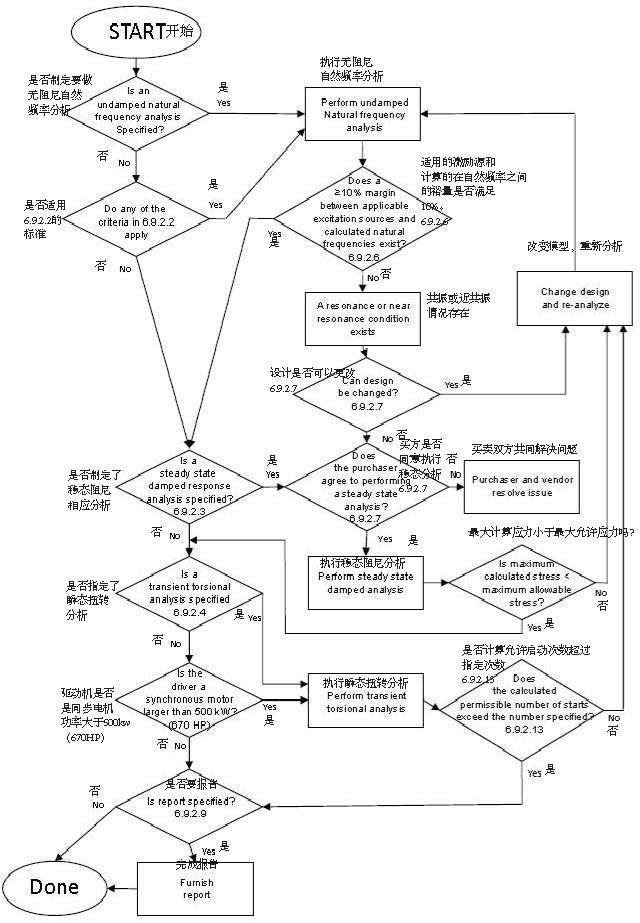 ==Figure 29 Torsional Analysis Flow Chart==
==图29—扭转分析流程图==
==Figure 29 Torsional Analysis Flow Chart==
==图29—扭转分析流程图==
6.9.2.3 If specified, for VFDs, a steady-state, forced response analysis shall be performed. The analysis shall consider all resonant frequencies through 12 times line frequency.
如果有规定,对于变频器,必须进行稳态强迫响应分析。分析应考虑所有共振频率到12倍的线性频率。
::: tip
解释:line frequency的意思就是电源线的频率,50HZ,和60HZ(美国),至于原因上上一页的注2说了。本条规定了变频器稳态强迫响应的分析频率上限。
:::
6.9.2.4 If specified or if the driver is a synchronous motor rated 670 hp (500 kW) or higher, a transient forced response analysis shall be performed. If performed, the time-transient analysis shall meet the requirements of
6.9.2.10 through 6.9.2.13.
如果有规定或驱动装置是额定功率为 670 马力(500 千瓦)或更高的同步电机,则必须进行瞬态强迫响应分析。如果进行了瞬态分析,则应符合下列要求 6.9.2.10 至 6.9.2.13 的要求。
::: tip
解释:基本所有的api都要求带有同步电机驱动的设备,如果其功率达到一定程度的话,就要执行瞬态强迫响应分析。
:::
NOTE Some purchasers choose to perform forced response transient analyses if generator phase-to-phase or phase- to-ground faults are considered a significant risk or if rapid bus switching occurs on loss of power.
注:如果认为发电机相-相或相-地故障具有重大风险,或者如果在失电时发生快速母线切换,则一些买方会选择执行强制响应瞬态分析。
6.9.2.5 Excitation of torsional natural frequencies can come from many sources, which might or might not be a function of running speed and should be considered in the analysis. These sources can include but are not limited to the following:
扭转固有频率的激励可能来自许多方面,可能是也可能不是运行速度的函数,在分析中都应加以考虑。这些来源可能包括但不限于以下方面:
::: tip
解释:下面列出了可能引起扭转振动的激励源。
:::
- a) pumps and HPRTs: 1 and 2 times rotor speed, impeller vane and cutwater pass frequencies;
泵和 HPRT(液力透平): 1 和 2 倍转子速度、叶轮叶片和切水通过频率;
::: tip
解释:cutwater之前解释过,cutwater pass frequencies等于泵的转速(每分钟转数)乘以叶轮叶片的数量。
:::
b) gears: mesh frequency;
齿轮:啮合频率
c) induction motors: 1 and 2 times the rotor speed and 1 and 2 times line frequency;
感应电机:1和2倍的转子速度,1倍和2倍的线频率
d) 2-cycle engines: n times the rotor speed where n is the number of power strokes per revolution;
两冲程发动机:转子转速的 n 倍,其中 n 为每转的功率冲程数;
e) 4-cycle engines: n and 0.5 times the rotor speed where n is the number of power strokes per revolution;
四冲程发动机:n 和 0.5 倍转子速度,其中 n 为每转的功率冲程数;
f) synchronous motors: n times the slip frequency (transient phenomena only), 1 and 2 times line frequency;
同步电机:n 倍转差频率(仅限瞬态现象),1 倍和 2 倍线路频率;
g) VFDs: n times the rotor speed, expressed in revolutions per minute, for relevant multiples through 12 times the line frequency, where n is the number of motor poles.
变频调速器:转子速度的 n 倍(以每分钟转数表示),相关倍数为线路频率的 12 倍,其中 n 为电机极数。
NOTE In case a torsional analysis of a train with VFDs, VFD torque harmonics are the excitation of concern. These torque functions, dependent on load, are normally requested from the drive manufacturer.
注:在对装有变频驱动装置的系列进行扭转分析时,变频驱动装置的扭矩谐波是需要关注的激励因素。这些取决于负载的扭矩函数通常需要从驱动器制造商处获得。
::: tip
解释:变频器的谐波是指变频器在整流和逆变过程中,产生的高于基波频率的正弦波分量。变频器的谐波会对电力系统和电力设备造成危害,如增加功率损耗、降低效率、干扰通信和测量、引起谐振和过热等。
:::
6.9.2.6 The torsional natural frequencies of the complete train shall be at least 10 % above or 10 % below any applicable excitation frequency, listed in 6.9.2.5, that falls within the specified range of operating speeds (from minimum to maximum continuous speed). If the natural frequency cannot be moved, it shall be shown to have no adverse effect.
整列系列的扭转固有频率必须至少高于或低于 6.9.2.5 所列的、在规定的运行速度范围内(从最低连续速度到最高连续速度)的任何适用激振频率的 10%。如果固有频率不能移动,则应证明不会产生不利影响。
::: tip
解释:这一条比较重要,要求了激励频率和固有频率之间的裕度关系。
:::
6.9.2.7 If torsional resonances are calculated to fall within the margin specified in 6.9.2.6 (and the purchaser and the vendor have agreed that all efforts to remove the resonance from within the limiting frequency range have been exhausted), a steady-state response analysis shall be performed to demonstrate that the resonances have no adverse effect on the complete train. The assumptions made in this analysis regarding the magnitude of excitation and the degree of damping shall be clearly stated. The acceptance criteria for this analysis shall be agreed upon by the purchaser and the vendor.
如计算出的扭转共振在 6.9.2.6 规定的裕度范围内(且买方和卖方已尽一切努力消除频率范围内的共振),则须进行稳态响应分析,以证明共振对整列系列无不利影响。分析中有关激励幅值和阻尼程度的假设应清楚说明。该分析的验收标准应由买方和卖方商定。
::: tip
解释:这里的裕度范围内,表示激振频率在固有频率的±10%范围内。无阻尼自然频率分析已经不满足要求,需要进一步稳态分析
:::
NOTE Typically, steady-state forced response torsional analyses of pumps driven by pulse-width-modulated variable- frequency drives have shown acceptably low stresses at the resonant conditions due to VFD excitations; these have no adverse effects on the machinery train.
注:通常情况下,对脉宽调制变频驱动器驱动的泵进行的稳态强迫响应扭转分析表明,由于变频驱动器的激励,共振条件下的应力较低,可以接受;这些应力不会对机械系统产生不利影响。
6.9.2.8 Unless otherwise specified, if only a steady-state, undamped torsional analysis is performed, a Campbell diagram with a tabulation of the mass elastic data and brief explanation of the calculation method may be furnished to the purchaser in lieu of a report.
除非另有规定,如果只进行稳态、无阻尼扭转分析,可向买方提供坎贝尔图,并附上质量弹性数据表和计算方法简要说明,以代替报告。
::: tip
解释:坎贝尔图大致如下,坎贝尔图是一种用于分析转子系统的振动特性的图形工具。它可以显示转子的固有频率和激振力频率随转速的变化情况,以及它们之间的共振点。坎贝尔图的横坐标是转速,纵坐标是频率。下图中的红色圆圈都是危险点。
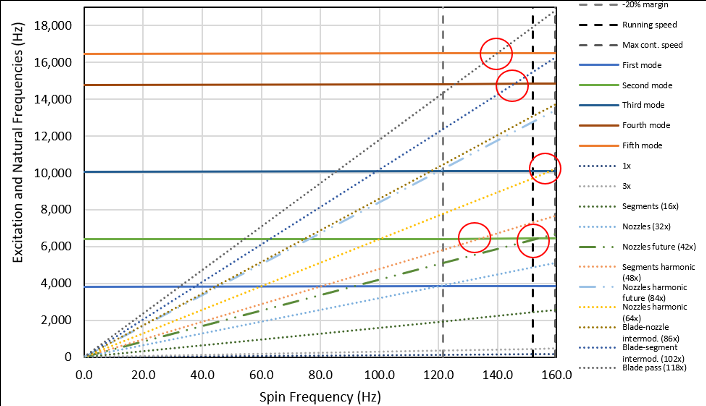 :::
:::
6.9.2.9 If specified, or if either a steady-state or transient forced response analysis is performed, the manufacturer shall furnish a detailed report of the torsional analysis. The report shall include the following:
如果有规定,或如果进行了稳态或瞬态强迫响应分析,制造商必须提供一份详细的扭转分析报告。报告应包括以下内容:
::: tip
解释:如下图
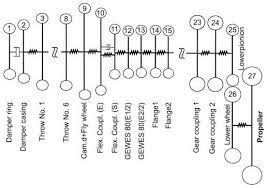 :::
:::
c) table of the mass moment and torsional stiffness of each element of the mass elastic system;
质量弹性系统各元素的质量力矩和扭转刚度表;
d) Campbell diagram;
坎贝尔图
e) mode-shape diagram with peak stresses shown for each resonant frequency.
模态振型图,每个共振频率都显示了峰值应力
::: tip
解释:以上内容,每个专业计算软件如dyrobes,ansys等都可以提供。
:::
6.9.2.10 In addition to the parameters used to perform, an undamped torsional natural frequency analysis as specified in 6.9.2.2, the following shall be included in the transient forced response analysis:
除了用于进行 6.9.2.2 中规定的无阻尼扭转固有频率分析的参数外,瞬态强迫响应分析还必须包括以下参数:
a) motor average torque, as well as pulsating torque (direct and quadrature axis) vs speed characteristics;
电机平均转矩以及脉动转矩(直接轴和正交轴)与速度的关系特性;
b) load torque vs speed characteristics;
负载扭矩与速度的关系特性;
c) electrical system characteristics affecting the motor terminal voltage or the assumptions made concerning the terminal voltage, including the method of starting, such as across the line, or some method of reduced voltage starting.
影响电机端电压的电气系统特性或对端电压的假设,包括启动方法,如跨线启动或某种降压启动方法。
6.9.2.11 A forced response analysis shall generate the maximum torque and, in case of a transient forced response analysis, a torque vs time history for each of the shafts in the train.
强制响应分析应产生最大扭矩,如果是瞬态强制响应分析,则应有整个机组系列中每个轴的扭矩随时间变化的历史记录。
The maximum torques shall be used to evaluate the peak torque capability of coupling components, gearing and interference fits of components, such as coupling hubs, and shaft locations with stress raisers such as keyways. The torque vs time history shall be used to develop a cumulative damage-fatigue analysis of shafting, keys, and coupling components.
最大扭矩应用于评估联轴器部件、齿轮和过盈配合部件(如联轴器毂)的峰值扭矩能力,以及带有应力集中(如键槽)的轴位置。应使用扭矩与时间的历史记录对轴、键和联轴器组件进行累积损伤-疲劳分析。
6.9.2.12 Appropriate fatigue properties and stress concentrations shall be used.
应使用适当的疲劳特性和应力集中。
6.9.2.13 An appropriate cumulative fatigue algorithm shall be used to develop a value for the safe number of starts and/or short-circuit events. The purchaser and vendor shall mutually agree as to the safe number of such events.
应使用适当的累积疲劳算法来确定启动和/或短路事件的安全次数。买方和卖方应共同商定此类事件的安全次数。
NOTE Values used depend on the analytical model used and the vendor s experience. Values of 1000 to 1500 starts are common. API 541 requires 5000 starts, which is a reasonable assumption for a motor. The driven equipment, however, would be overdesigned to meet this requirement.
注:使用的数值取决于所使用的分析模型和供应商的经验。1000 到 1500 次启动的数值很常见。API 541 要求达到 5000 次启动,这对电机来说是一个合理的假设。不过,为满足这一要求,被驱动设备的设计将过于复杂。
::: tip
解释:机组的启停是最容易出现问题的过程。
:::
6.9.3 Balancing平衡
6.9.3.1 Impellers, balancing drums, and similar major rotating components shall be dynamically balanced to ISO 21940-11, Grade G2.5. The mass of the arbor used for balancing shall not exceed the mass of the component being balanced. Shafts are not required to be balanced. For single-stage BB1 and BB2 pump rotors with interference fit components, the vendor may choose to balance the assembled rotor (in accordance with 9.2.4.2) instead of balancing major rotating components individually.
叶轮、平衡鼓和类似的主要旋转部件必须按照 ISO 21940-11, G2.5 级进行动平衡。用于平衡的心轴质量不得超过被平衡部件的质量。轴无需进行平衡。对于带有过盈配合部件的单级 BB1 和 BB2 泵转子,卖方可选择平衡组装转子(符合 9.2.4.2),而不是单独平衡主要旋转部件。
::: tip
解释:arbor(心轴)是一种用于平衡旋转部件的工具,它可以模拟部件在实际安装时的状态,将部件固定在平衡机上进行测量和校正。arbor的形状和尺寸要与部件的安装方式相匹配,例如锥度、孔径、键槽等。arbor的质量要小于或等于部件的质量,以避免增加平衡机的负载和误差。如下图,就是心轴,用心轴代替真正的轴,为什么不用真正的轴呢?arbor的长度和重量更适合平衡机的规格,不超过平衡机的最大容量。arbor的形状和结构更适合平衡机的夹持方式,能够牢固地固定在平衡机上,且不影响平衡机的旋转。
 :::
:::
NOTE In ISO 21940-11 standards, unbalance is expressed as a balance quality grade. Each of the ISO balance quality grades covers a range of unbalance. The nominal equivalent USC unit limits given throughout this standard correspond approximately to the midpoint of the ISO range.
注:在 ISO 21940-11 标准中,不平衡度以平衡质量等级表示。ISO 平衡质量等级中的每个等级都涵盖一定范围的不平衡度。本标准中给出的标称等效 USC 单位限值大致相当于 ISO 范围的中点。
::: tip
解释:平衡等级从G0.4到G400大致分为11个等级。每一个等级有不同的不平质量要求。
:::
6.9.3.2 Component balancing may be single-plane if the ratio D/b (see Figure 30) is 6 or greater.
如果比率 D/b(见图 30)为 6 或更大,则可采用单面平衡。
::: tip
解释:平衡分为静平衡和动平衡,静平衡又成为单面平衡,动平衡又称为双面平衡。如果D/b的数值≥6,说明所平衡部件更像一个厚度很小的大圆盘,因此采用静平衡就能满足平衡要求。
:::
6.9.3.3 Rotor balancing shall be performed as required in the specific pump sections.
必须按照泵的具体章节要求进行转子平衡。
::: tip
解释:说的就是按照第9章内容进行
:::
6.9.3.4 If specified, impellers, balancing drums, and similar rotating components shall be dynamically balanced to ISO 21940-11, Grade G1.
如有规定,叶轮、平衡鼓和类似的旋转部件必须按照 ISO 21940-11 G1 级进行动平衡。
::: tip
解释:一般对于泵来说,G2.5的动平衡等级就够了
:::
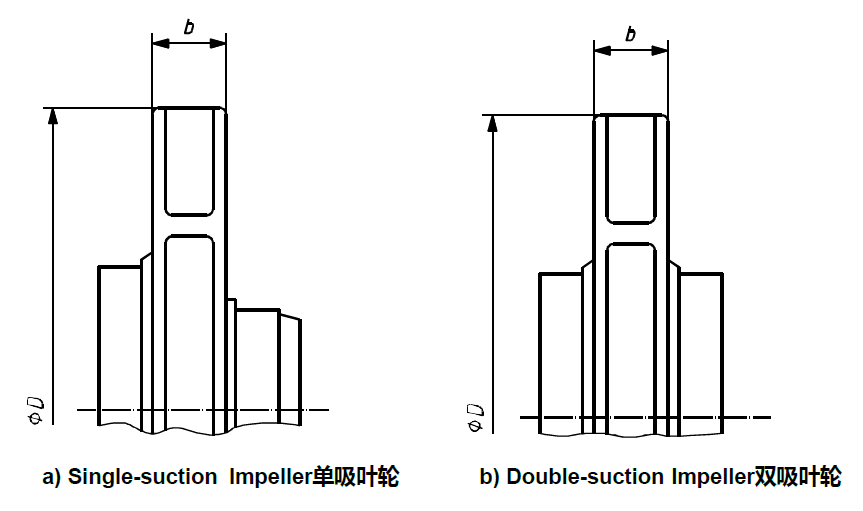
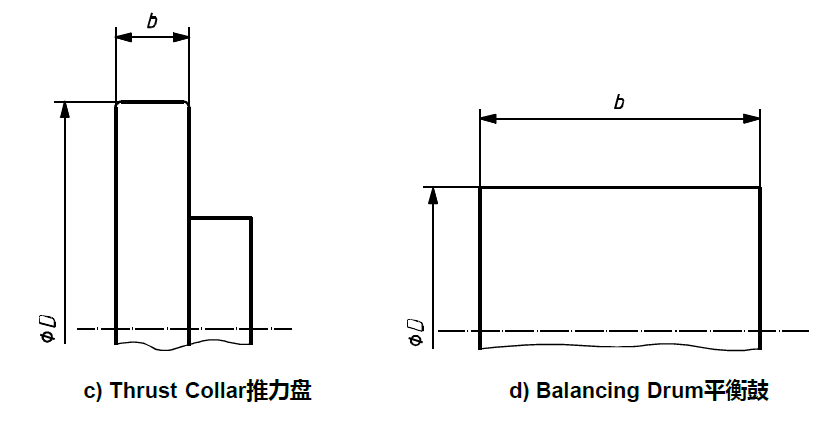
Key
b width宽度
D diameter直径
==Figure 30 Rotating Component Dimensions to Determine if Single-plane Balancing Is Allowable==
==图30—转子部件尺寸来确定是否允许单面平衡==
6.9.3.5 If specified, impellers, balancing drums, and similar rotating components shall be dynamically balanced to:
如果有规定,叶轮、平衡鼓和类似的旋转部件必须进行动平衡,以:
U = 4W/n
In USC units where
USC单位制,式中
U is the unbalance per plane, expressed in ounce-inches;
U 是每个平面的不平衡度,单位为盎司-英寸
W is the component mass (for components), expressed in pounds; or the load per balancing machine journal (for rotors), expressed in pounds;
W 是组件质量(对于组件),以磅为单位;或每个平衡机轴颈的负载(对于转子),以磅为单位
n is the rotational speed of the pump, expressed in revolutions per minute.
n 是泵的转速,以每分钟转数表示
NOTE 4W/n is a balance tolerance denominated solely in USC units. With modern balancing machines, it is feasible to balance components mounted on their arbors to U =4W/n (USC units), or even lower depending upon the mass of the assembly, and to verify the unbalance of the assembly with a residual unbalance check. However, balancing to ISO Grade G1 or U =4W/n (USC units) is generally not repeatable when the components are dismantled and remounted on their arbors, because of the minute mass eccentricity values associated with these fine levels of unbalance requirements. See 9.2.4.2.2.
注:4W/n 是仅以 USC 单位表示的平衡公差。使用现代平衡机,可以将安装在心轴上的组件平衡至 U=4W/n(USC 单位),甚至更低,这取决于组件的质量,并通过残余不平衡检查来验证组件的不平衡。然而,当组件被拆卸并重新安装到心轴上时,ISO G1 级或 U= 4W/n(USC 单位)的不平衡度通常是不可重复的,因为与这些微小的不平衡度要求相关的质量偏心值很小。参见 9.2.4.2.2。
::: tip
解释:G1的复现度很低。第一次试验达到了G1的平衡等级,如果重复试验,可能就达不到了。
:::
6.9.4 Vibration振动
6.9.4.1 Centrifugal pump vibration varies with flow, usually being a minimum in the vicinity of BEP flowrate and increasing as flow is increased or decreased. The change in vibration as flow is varied from BEP flowrate depends upon the pump s energy density, its specific speed, and its suction-specific speed. In general, the change in vibration increases with increasing energy density, higher specific speed, and higher suction-specific speed.
离心泵的振动随流量而变化,通常在最佳效率点附近为最小值,随着流量的增减而增大。流量从最佳效率点开始改变时,泵的振动变化取决于泵的能量密度、比转速和吸入比转速。一般来说,振动的变化随着能量密度的增加、比转速的提高和吸入比转速的提高而增大。
::: tip
解释:大泵的能量密度更大,比转速也高,吸入比转速也高,因此偏离最佳效率点时,振动增大量更大。
:::
With these general characteristics, a centrifugal pump’s operating flow range can be divided into two regions, one termed the preferred operating region, over which the pump exhibits low vibration, the other termed the allowable operating region, with the limits both high and low, defined as those flowrates at which the pump s vibration reaches a higher but still “acceptable” level. Figure 31 illustrates the concept. Factors other than vibration, e.g. temperature, rise with decreasing flow, or NPSH3 with increasing flow, can dictate a narrower allowable operating region.
根据这些一般特性,离心泵的工作流量范围可分为两个区域,一个称为优先工作区域,在该区域内泵的振动较小;另一个称为允许工作区域,其极限既高又低,定义为泵的振动达到较高但仍 "可接受 "水平的流量。图 31 举例说明了这一概念。除振动之外的其他因素,如温度随流量降低而升高,或 NPSH3 随流量增加而升高,都可能导致允许工作区变窄。
::: tip
解释:温度之所以随着流量降低而升高,是因为流量降低,效率降低,导致损失都转化成了热能。
优先工作区和允许工作区是最常用的两个概念。
:::
The allowable operating region shall be stated in the proposal. If the allowable operating region is limited by a factor other than vibration, that factor shall also be stated in the proposal.
应在投标书中说明允许工作区。如果允许的工作区受到振动以外因素的限制,也应在投标书中说明该因素。
6.9.4.2 During the performance test, overall vibration measurements over a frequency range of 5 Hz to 1000 Hz and discrete vibration measurements using fast Fourier transform (FFT) spectra shall be made at a minimum of five test points. These points shall include the rated flow point and the points defining the minimum and maximum flows for the allowable and preferred operating ranges. Vibration measurements are not required at shutoff. Vibration measurements shall be made at the following locations:
在性能试验期间,必须在至少五个试验点上,进行频率范围为 5 赫兹至 1000 赫兹的振动测量和使用快速傅立叶变换频谱的离散振动测量。这些测试点应包括额定流量点以及确定允许和优先工作区的最小和最大流量点。关闭点的位置不需要进行振动测量。必须在以下位置进行振动测量:
::: tip
解释:5个点(额定流量点,允许工作区的最大和最小点,优先工作区的最大点和最小点。)
FFT就是快速傅里叶变化,将振动从时域改为频域,就能很好的看出具体在哪个频率上振动贡献最大。
:::
a) on the bearing housing(s) or equivalent location(s) of all pumps, at the positions shown on Figure 32, Figure33, and Figure 34 (it is recommended that vibration readings be taken in both horizontal and vertical planes at the rated point and at all other points in the same plane as the higher reading);
在图 32、图 33 和图 34 所示位置的所有泵的轴承箱或同等位置上 (建议在额定流量点下的水平和垂直平面上以及与较高振动读数同一平面上的所有其他点上采集振动读数);
::: tip
解释:一般就是图 32、图 33 和图 34上的H和V方向,或者X和Y方向测量振动。
:::
b) on the shaft of pumps with hydrodynamic bearings both X and Y, if the pump has provisions for proximity probes.
带有 X 和 Y 流体动压轴承的泵轴上,如果该泵配有接近式探头。
::: tip
解释:接近式探头,就是电涡流探头,如本特利3300系列。
:::
6.9.4.3 The FFT spectra shall include the range of frequencies from 5 Hz to 2Z times running speed (where Z is the number of impeller vanes; in multistage pumps with different impellers, Z is the highest number of impeller vanes in any stage). The plotted spectra shall be included with the pump test results.
FFT 频谱应包括从 5 赫兹到 2Z 倍运行速度的频率范围(其中 Z 为叶轮叶片数;在具有不同叶轮的多级泵中,Z 为任何一级中的最高叶轮叶片数)。绘制的频谱图应与泵测试结果一起提供。
::: tip
解释:Z一般为质数,如5,7,11等。频谱图如下图所示。
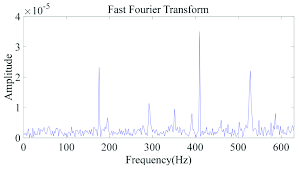 :::
:::
NOTE The discrete frequencies 1.0, 2.0, and Z times running speed are associated with various pump phenomena and are, therefore, of particular interest in the spectra.
注:1.0、2.0 和 Z 倍运行速度的离散频率与各种泵现象有关,因此在光谱中特别引人关注。
::: tip
解释:泵现象指的是,不对中,不平衡等振动现象,往往和1倍,2倍,Z倍频率有关。Z就是叶轮叶片数。
:::
6.9.4.4 Bearing-housing overall vibration measurements shall be made in root mean square (RMS) velocity, expressed in inches per second (millimeters per second).
轴承承座整体振动测量应采用均方根(RMS)速度,单位为英寸/秒(毫米/秒)。
::: tip
解释:此为壳振,壳振用mm/s表示。
:::
6.9.4.5 Shaft vibration measurement shall be peak-to-peak displacement, in mils (micrometers).
轴振动测量应为峰-峰位移,单位为密耳(微米)
::: tip
解释:此为轴振,轴振用微米表示。
:::
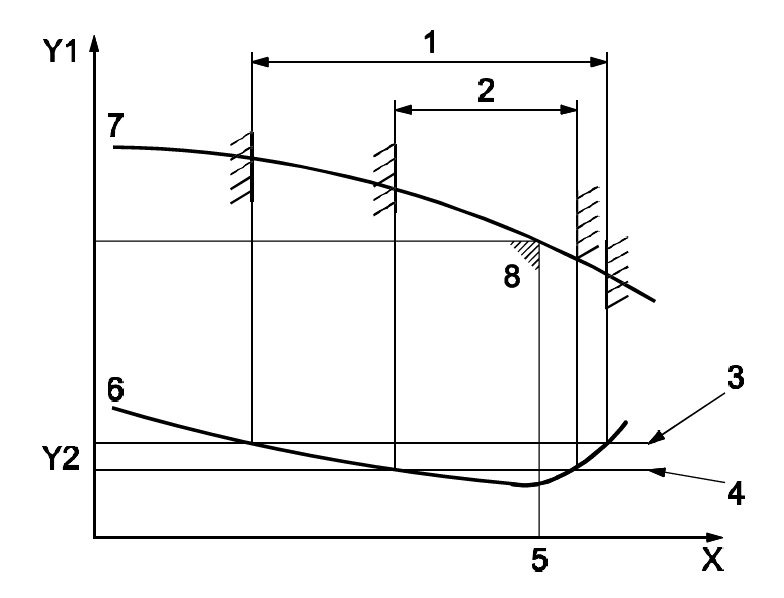 Key
X flowrate流量
Y1 head扬程
Y2 vibration振动
1 allowable operating region of flow允许工作区
2 preferred operating region of flow优先工作区
3 maximum allowable vibration limit at flow limits流量范围内的最大允许振动极限
4 basic vibration limit基本振动极限
5 best efficiency point, flowrate最佳效率点,流量
6 typical vibration vs flowrate curve showing maximum allowable vibration典型振动与流量关系曲线,展示出最大允许振动
7 head-flowrate curve扬程流量曲线
8 best efficiency point, head and flowrate最佳效率点,扬程和流量
==Figure 31 Relationship Between Flow and Vibration==
==图31—流量和振动之间的关系==
Key
X flowrate流量
Y1 head扬程
Y2 vibration振动
1 allowable operating region of flow允许工作区
2 preferred operating region of flow优先工作区
3 maximum allowable vibration limit at flow limits流量范围内的最大允许振动极限
4 basic vibration limit基本振动极限
5 best efficiency point, flowrate最佳效率点,流量
6 typical vibration vs flowrate curve showing maximum allowable vibration典型振动与流量关系曲线,展示出最大允许振动
7 head-flowrate curve扬程流量曲线
8 best efficiency point, head and flowrate最佳效率点,扬程和流量
==Figure 31 Relationship Between Flow and Vibration==
==图31—流量和振动之间的关系==
::: tip
解释:在优先工作区2的范围内,测量的振动应该在4的横线下(壳振对应的数值为3mm/s),在优先工作区外,但是仍然在允许工作区1的范围内,测量的振动应该在3的横线下(壳振对应的数值为3.3mm/s)
:::
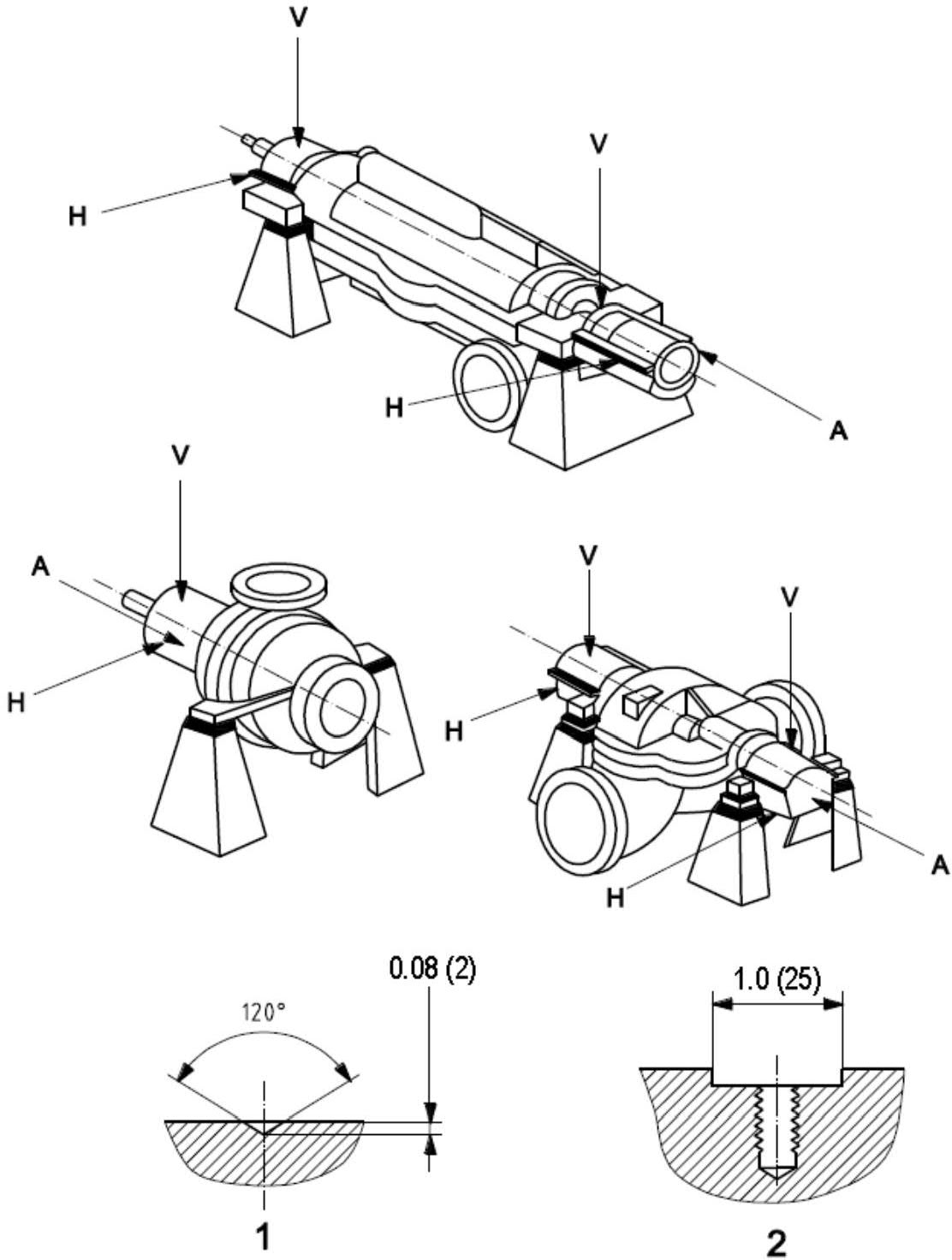
Key关键点
1 dimple (see 6.10.2.12)凹槽(见6.10.2.12)
2 optional arrangement for mounting vibration-measuring equipment (see 6.10.2.13)
安装振动测量设备的可选布置(见 6.10.2.13)
A axial轴向
H horizontal 水平向
V vertical 竖直向
==Figure 32 Locations for Taking Vibration Readings on OH and BB Type Pumps==
==图32—在OH和BB型泵上测量振动读数的位置==
Dimensions in inches (millimeters)
用英寸(mm)表示的尺寸
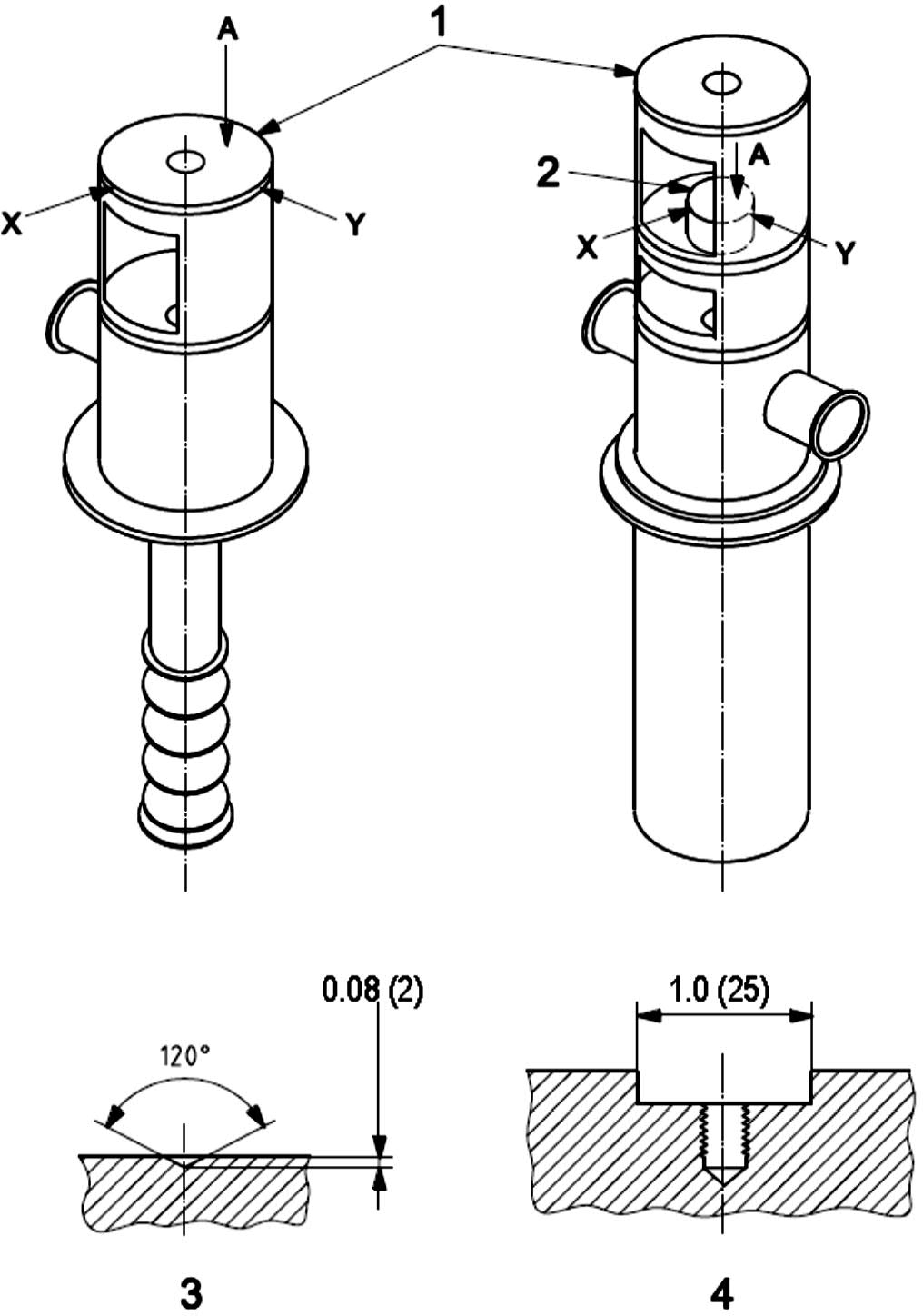
Key
1 driver mounting surface 电机安装面
2 pump bearing housing 泵轴承箱
3 dimple (see 6.10.2.12)凹槽(见6.10.2.12)
4 optional arrangement for mounting vibration-measuring equipment (see 6.10.2.13)
安装振动测量设备的可选布置(见 6.10.2.13)
A axial 轴向
==Figure 33 Locations for Taking Vibration Readings on Vertically Suspended (VS) Pumps==
==图33—在VS型泵上测量振动读数的位置==
Dimensions in inches (millimeters)
用英寸(mm)表示的尺寸
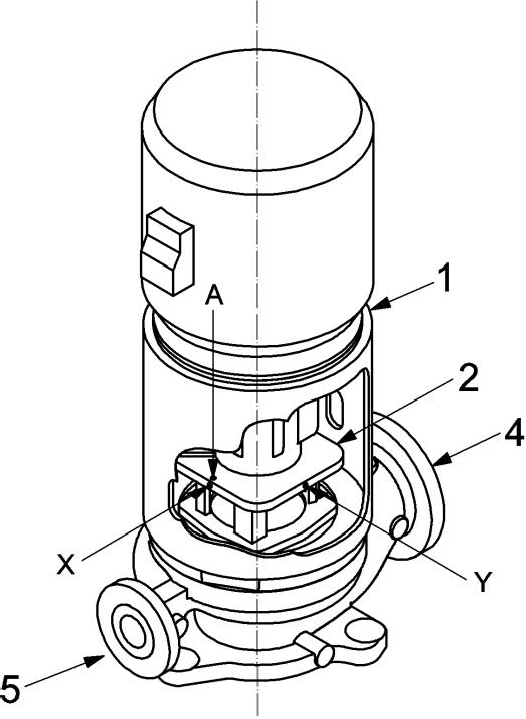
==a) Vertical In-line (OH3) Pump b) High-speed Integrally Geared (OH6) Pump==
==立式管道泵OH3==
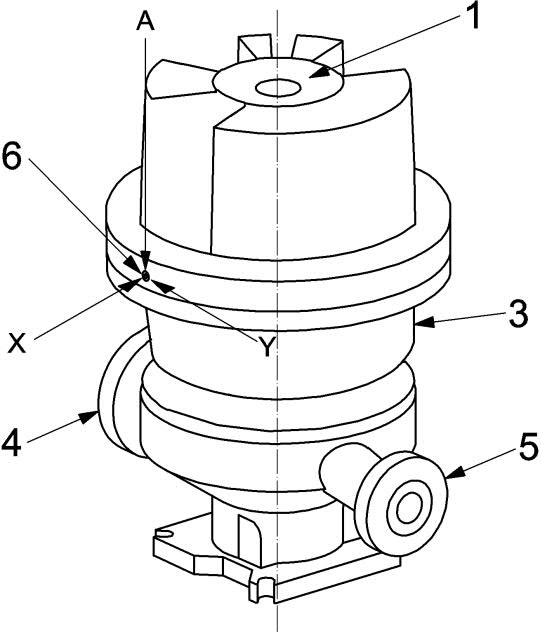
==b) High-speed Integrally Geared (OH6) Pump==
==立式管道泵OH3 集成齿轮的高速泵OH6==
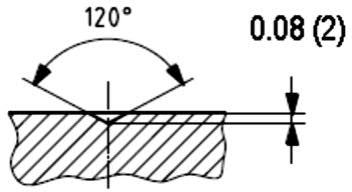
==c) Dimples凹槽==
==(see 6.10.2.12)==
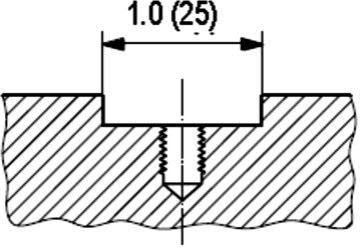
==d) Arrangement for Mounting Vibration-measuring Equipment==
==安装振动测量设备的可选布置==
(see 6.10.2.13)
Key
1 driver mounting surface电机安装面
2 pump bearing housing泵轴承箱
3 gearbox housing齿轮箱
4 suction flange吸入法兰
5 discharge flange排出法兰
6 threaded connection for stud-mounting vibration sensor螺纹连接,用于螺柱安装振动传感器
A axial轴向
==Figure 34 Locations for Taking Vibration Readings on Vertical In-line (OH3) and High-speed Integrally Geared (OH6) Pumps==
==图34—立式管道泵OH3和高速集成齿轮泵OH6的测振位置==
6.9.4.6 The vibration measured during the performance test shall not exceed the values shown in the following:
性能试验期间测得的振动不得超过下列数值:
a) Table 8 for overhung and between-bearing pumps 表 8 适用于悬臂泵和两端支撑泵
b) Table 9 for vertically suspended pumps,表9适用于立式悬吊泵
c) Figure 35 for high-energy pumps.图35使用图高能泵
Pumps furnished with proximity probes shall meet both bearing-housing and shaft-vibration limits.
如果泵配置了接近式探头,那应该既遵守轴承箱振动限制,也遵守轴振限值
::: tip
解释:这条需要注意,有些滑动轴承的泵不设置轴振,那么就要遵守壳振(轴承箱振动)的要求。
:::
NOTE Bearing housing overall vibration limits are defined for RMS measurements only.
注:轴承箱整体振动限值仅用于有效值测量(RMS)。
==Table 8 Vibration Limits for Overhung and Between-bearings Pumps==
==表8—悬臂和两端支撑泵的振动限值==
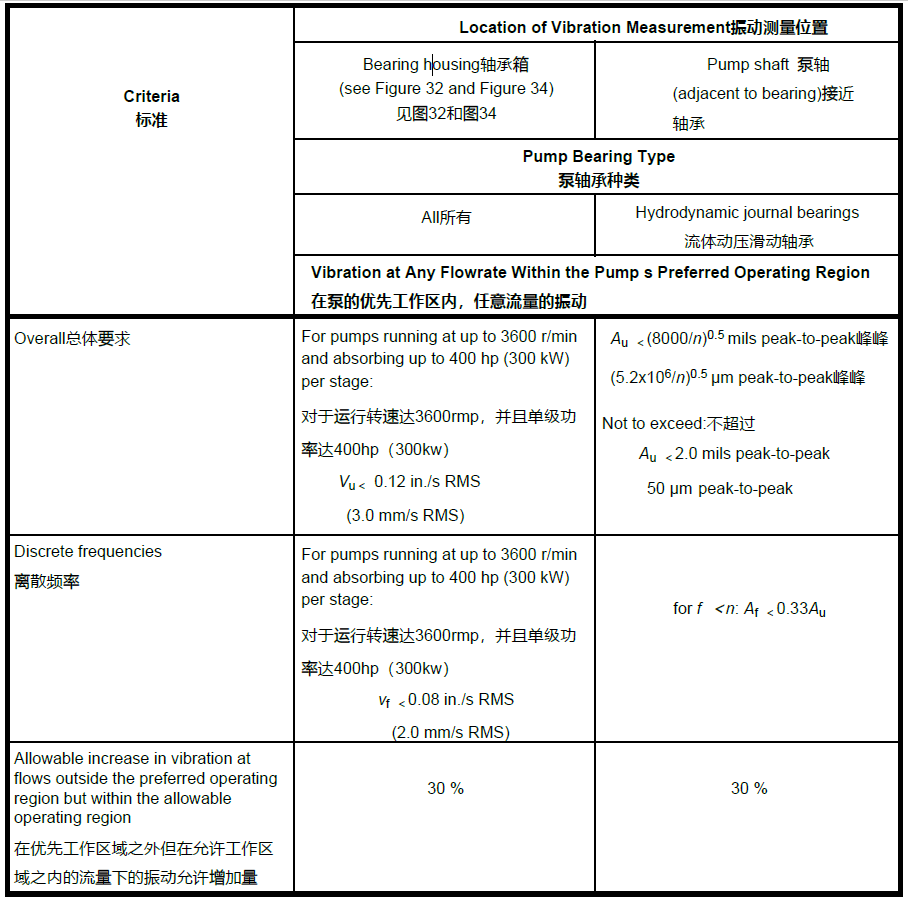
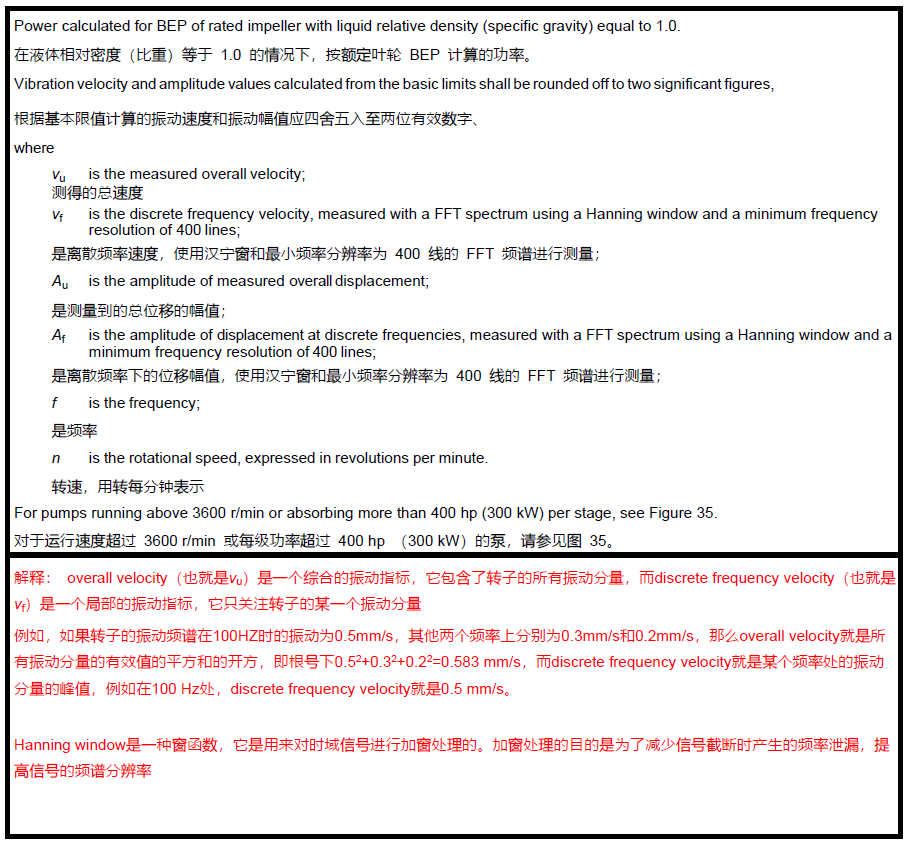
==Table 9 Vibration Limits for Vertically Suspended Pumps==
==立式悬吊泵振动限值==
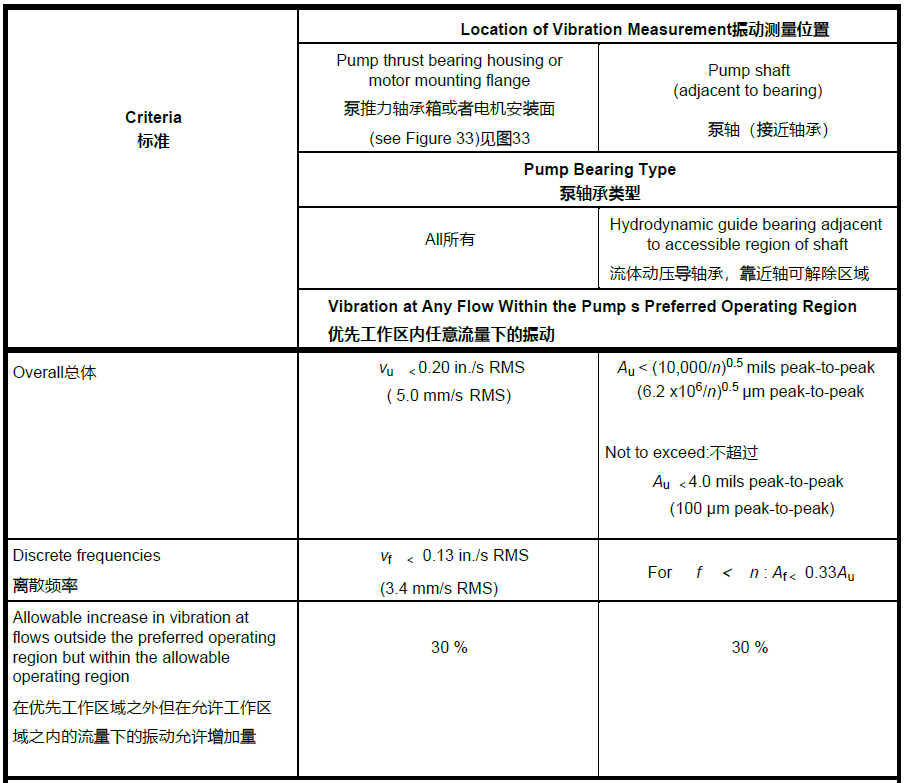
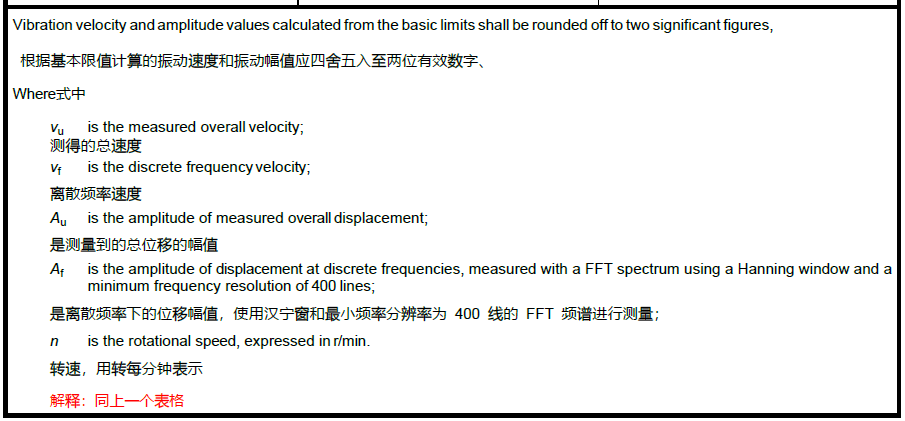
6.9.4.7 At any speed greater than the maximum continuous speed, up to and including the trip speed of the driver, the vibration shall not exceed 150 % of the maximum value recorded at the maximum continuous speed.
Vibration exceeding this limit, but below the allowable limit in the table may be accepted with purchaser's approval.
在任何大于最大连续转速的速度下,直至并包括驱动机的跳闸转速,振动不得超过在最大连续转速下记录的最大值的 150%。超过此限值但低于表中允许限值的振动,经买方批准后可以接受。
::: tip
解释:比如最大连续转速下的振动为1mm/s,则跳闸转速下最大为1.5mm/s,但是如果实际跳闸转速下为3mm/s,虽然超过了1.5但是仍然在表格的要求内。
:::
6.9.4.8 Variable-speed pumps shall operate over their specified speed range without exceeding the vibration limits of this standard.
变速泵应在规定的转速范围内运行,不得超过本标准规定的振动限值。
6.9.4.9 If the vendor can demonstrate that electrical or mechanical runout is present, the demonstrated amount of runout can be vectorially subtracted from the measured vibration during the factory test as long as it does not exceed 25 % of the allowed peak-to-peak vibration amplitude or 0.25 mil (6.5 μm), whichever is less.
如果卖方能证明存在电气或机械跳动,只要不超过允许振动峰-峰振幅的 25% 或 0.25 mil (6.5 μm)(以较小者为准),则可在出厂测试时从测量振动中矢量减去所证明的跳动量。
::: tip
解释:这句话的意思是,电气或者机械跳动属于干扰项,可以在测量的振动中矢量减去。
:::
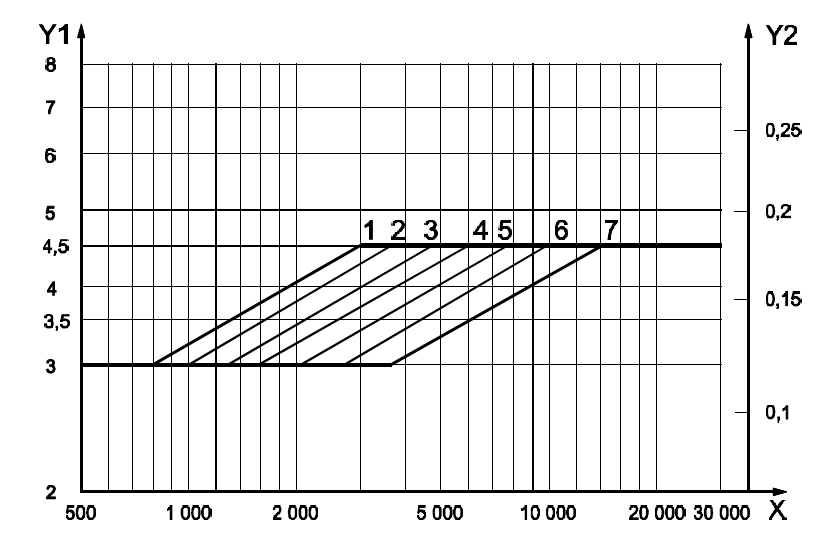
Key
X rotational speed, n expressed in revolutions per minute
转速,n表示为转每分钟
Y1 vibrational velocity, vu expressed in millimeters per second, RMS
振动速度,vu表示为mm/s,RMS(均方根)
Y2 vibrational velocity, vu expressed in inches per second, RMS
振动速度,vu表示为in/s,RMS(均方根)
1 P 3000 kW/stage(级)
2 P = 2000 kW/stage(级)
3 P = 1500 kW/stage(级)
4 P = 1000 kW/stage(级)
5 P = 700 kW/stage(级)
6 P = 500 kW/stage(级)
7 P 300 kW/stage(级)

==Figure 35 Bearing Housing Vibration Limits for Horizontal Pumps Running Above 3600 r/min or Absorbing More Than 400 hp (300 kW) per Stage==
==图35—大于3600r/min或者单级功率超过400hp(300kw)水平泵的轴承箱振动限值==
::: tip
解释:由此可见,对于高能泵,其振动限制比一般泵高,要求更宽松。
:::